April 2017. Six years ago, in March 2011, I was in eastern Ukraine, near the western edge of the Eurasian steppe ecoregion that sprawls across the continent from Mongolia to the Danube. These grasslands were the habitat for our hunter ancestors who came out of Africa and ranged along the southern edge of the ice sheet that once covered the northern part of the continent, chasing and killing mammoths and other megafauna. Much later, for millennia, they supported horse-riding, herding nomads, from Scythians to Mongols. The landscape is grand and beautiful, rolling big sky country that reminded me of the Dakotas. I wrote then about spring on the steppe, with wild crocus and larks. This time it was wild tulips and cranes.
I was here again, as in 2011, to conduct a biodiversity assessment for the U.S. Agency for International Development (USAID). I love doing assessments like this, because I not only get to talk to many of the leading ecologists and natural resource managers in a country, but also to visit protected areas in a variety of the country’s ecosystems. A significant fraction of the stories posted here on my blog are based on this type of work, which has by now taken me to Bolivia, Guatemala, Kenya, Mozambique, Namibia, Tanzania, Serbia, and Ukraine. My assessment team members this time were two Ukrainian conservation biologists, Alena and Olga, each with lots of international experience and fluent in Ukrainian, Russian, and English. We were working under a contract with ECODIT, a small consulting firm based in the Washington, DC, area, which had been invited by USAID-Ukraine to field our assessment team.
That morning at 7 AM I’d met Olga and Alena at the cavernous Soviet-era train station in Kyiv, Ukraine’s capital city. We boarded a train at 7:30 AM, heading south down the Dnieper River – Ukraine’s Mississippi, more or less. Our destination was Kherson, a city at the top of the Dnieper Delta – Ukraine’s New Orleans, more or less. We arrived in the late afternoon, and met with the head of the regional office of the Ministry of Ecology and Natural Resources, which is in charge of all of the protected areas in the Kherson region. Leaving Kherson at dusk after the meeting, we drove across a big bridge spanning the Dnieper, and eastward into the dark in a Toyota RAV4 rented from Avis Ukraine. Our destination was Askania Nova Biosphere Reserve. Our kamikaze driver, Sergiy, sped along the deserted highway; I was too tired to do more than hope he missed the potholes. Finally by 9 PM we were in Askania Nova, checking into our rooms in the Hotel Kanna, where it seemed we were the only guests.
I left my bags in a huge, cold room, and joined Alena and Olga in the cold restaurant. The proprietress was eager to get us fed and out so she could go home. After a typical Ukrainian dinner of soup, bread, salad, and meat, aided and abetted, luckily, by a cold local beer, I was back in my room again. The electric heat had kicked on and warmed it up. I was thankful for that hydroelectric heat from the big dams on the Dnieper – or maybe from nuclear plants, of which Ukraine still has many, their inheritance from the Soviet era and its Chernobyl meltdown. The room had a 1950s “retro” feel that reminded me vaguely of the styles I grew up with. I had noticed that in 2011 at our hotel in Donetsk, in eastern Ukraine. In this room, I especially liked the carpet, and styling of mirrors, furniture, and lamps. What was going on back then in the former USSR, that they were so “modern” and “stylish” and “cool”?
As I drifted off to sleep in the now-warm room, the carpet pattern became a dreamy image of a mosaic ecological landscape. I dreamed of a green harmony of multiple uses of the land, from farms to native grasslands grazed by… mammoths? saiga? sheep? If any of those beasts grazed through my dreams, I didn’t remember them when my alarm jolted me awake at 6:45 and sent me down to breakfast in the unheated restaurant. Breakfast was as prosaic as dinner had been – but bless them, they had an espresso machine that made decent café americano!
——-
After breakfast we drove to the campus-like headquarters of the Askania Nova Biosphere Reserve, which is registered under UNESCO’s Man and the Biosphere Program. Its history is deep and rich, as we learned from the director, Viktor Gavrilenko. He arrived in a tiny Soviet-era mini-jeep, appropriately olive drab in color, and whisked us off on a whirlwind three-hour tour of his empire. He has been director here for 27 years.
From the headquarters buildings, Viktor drove us through a forest of trees from all over the world, a large botanic garden really, while he related its history. He had a practiced and polished tour-guide spiel that was fascinating, but nearly impossible to cut into with questions; I tried my best when I was curious about some detail. From the mysterious 2,500-year-old stone statues of women that marked the “salt route” from the Azov Sea across the waterless, trackless steppe, to the German eco-engineering that brought water up from an underground aquifer for the botanic garden and a giant sheep ranching operation, to a pioneering experiment in conserving vanishing steppe animals, this is a fascinating place.
The history of steppe conservation here reaches back more than a century, to Friedrich Falz-Fein (1863–1920), the eldest son of German settlers, who took over the family property near the German colony of Askania Nova after finishing his university studies in natural science at the University of Dorpat, in what is now Estonia. German immigration had been welcomed in southern Ukraine since the time of Catherine the Great, who ruled Russia from 1762 to 1796 and incorporated what is now Ukraine into her empire. Falz-Fein developed Askania Nova as a sheep ranch, said to have nearly a million sheep and 100,000 shepherd dogs, which also supplied horses to the Russian army. In 1883 he created an enclosure on native steppe for keeping wild steppe animals such as saiga antelope. In 1899 he brought a small herd of Przewalski’s horses, which were even then nearly extinct in the wild, from the Mongolian steppe to Askania Nova. Falz-Fein was motivated by his realization that the steppe ecosystem, and especially its fauna, were threatened and disappearing, due in many ways to economic changes such as his own family’s sheep ranch.
After the Russian Revolution, the Bolsheviks confiscated the property in 1918, and the Falz-Fein family fled to Germany, except for Friedrich’s mother, who refused to leave and was executed by the Red Army. Under Stalin, Askania Nova was divided into agricultural cooperatives, but a core nature preserve was maintained as a State Steppe Reserve of the Ukrainian Soviet Socialist Republic. The main purpose of the reserve was to preserve and study the environment of virgin steppe. That was the enduring legacy of the “zapovednost” conservation philosophy of Vasily Dokuchaev, a pioneering Russian geographer who died before the revolution – but more on “zapovednost” later. In 1984, Askania-Nova was designated as a biosphere reserve under the UNESCO Man and the Biosphere Program, and Ukraine retained that status after the fall of the Soviet Union and its independence in 1991.
We parked at the edge of the artificial forest created by Falz-Fein’s tapping of the underground aquifer, climbed to the top of a small hill, and looked out across a brown sea of ungrazed steppe to the horizon under a grey sky. We were looking at part of the core “zapovednik,” or nature preserve, section of Askania Nova. With binoculars, we could see one of the stone statues supposedly placed by the Scythians as route markers, still standing after 2,500 years.
——-
After descending the hill, Victor drove to a gate that opened into a huge fenced area of native grassland, the enclosed park that Falz-Fein had established for endangered steppe animals. Although the habitat was natural, these fenced pastures had the feeling of a drive-in zoo and felt a little surreal.
The grassland here was grazed, and so was green with a flush of new spring grass, not buried in the brown of last year’s dead, uneaten grass like the ungrazed steppe we’d seen from the hill. This steppe pasture held a swirling herd of a few hundred saiga (Saiga tatarica). Saiga are a steppe antelope with a pale coat that run with a gate more like a dog than that of the bounding and springing African antelopes I’m used to seeing, which are the saiga’s closest relatives. Saiga have a unique face, with elongated, drooping nostrils that are thought to warm frigid air in winter and to cool hot summer air and filter dust on migrations across the steppe. The species is considered critically endangered by the World Conservation Union, IUCN.
In another area, we watched a large herd of red deer (Cervus elaphus), the Eurasian ecological equivalent and sister species of the North American elk, or wapiti (Cervus canadensis). Viktor said that red deer would have been found here on the steppe before their local extinction. In North America, elk ranged widely across the plains grasslands also, before their local extinction there.
Where a large seasonal lake and marsh had once existed, providing an oasis for migrating cranes, waterfowl, and shorebirds, artificially-controlled water levels now try to recreate that habitat year-round. We watched flights of grey Eurasian cranes, calling with the haunting calls all cranes have, circling under grey skies. This crane is the crane, given its scientific name Grus grus by Linnaeus, the “crane crane.”
Viktor stopped suddenly at the edge of a pasture where bright yellow wild tulips, Tulipa scythica, scattered across the green grassland. This endemic species of tulip is found only on the steppe of southeastern Ukraine and is listed in the Ukraine Red Book of threatened and endangered species as “disappearing.” Askania Nova is one of the last holdouts of this endangered species, whose scientific name honors the Scythians.
Through another gate we entered another enclosure to meet the director’s pride and joy, Askania Nova’s herd of Przewalski’s horses. The taxonomic status of Przewalski’s horse is equivocal. Wikipedia, citing authoritative scientific sources, says that “the taxonomic position of Przewalski’s horse remains controversial and no consensus exists whether it is a full species (Equus przewalskii), a subspecies of the wild horse (Equus ferus przewalskii), or even a sub-population of the domestic horse (Equus ferus caballus).” IUCN, which maintains the global Red List of threatened and endangered species, says that “Current scientific review of the taxonomy of wild equids places Przewalski’s Horse as a subspecies of the extinct Equus ferus,” and notes that both genetic and morphological differences suggest significant evolutionary differences between Przewalski’s horse and domestic horses. No matter what their evolutionary status, Viktor’s familiar shouts and exhortations eventually persuaded the semi-tame herd to come over and greet us, and we could touch their wide faces and feel their unhorselike, erect manes – more like those of zebras than of domestic horses.
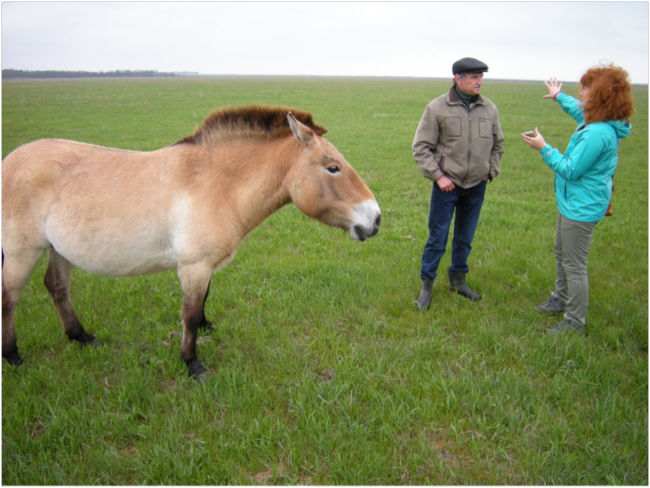
Conference at Askania Nova with Przewalski’s horse, Biosphere Reserve Director Viktor Gavrilenko, and biodiversity consultant Alena Tarasova-Krasiieva
——-
Vasily V. Dokuchaev (1846-1903) was a Russian geologist and geographer who laid the foundations of soil science. Because of him, Russian names for soil types are common, such as “chernozem” for the black soils like those found on the Ukrainian steppe. Dokuchaev also helped develop a unique Russian model of protected areas, called “zapovedniks,” which can best be translated into English as “nature preserves” or “nature sanctuaries.” The scientific and philosophical justification for nature sanctuaries of this type, developed in the 1890s mainly by Dokuchaev, is known as “zapovednost” in Russian. Dokuchaev argued that setting aside areas of pristine natural ecosystems that can be studied and compared with managed ecosystems, such as agricultural lands or managed forests, was ultimately important for economic development, in case they could provide clues about how human actions were affecting natural processes. People and all economic activities should be excluded, he argued, and rangers should protect the areas and scientists should study their natural functioning.
In the United States, this model of “nature preserves” exists to a certain extent in our federal national wildlife reserve system, and in some areas protected by The Nature Conservancy. But in the U.S., the larger philosophical foundation of nature conservation is more spiritual and recreational, growing out of the writings of John Muir, John Burroughs, and Teddy Roosevelt – “national parks” – in contrast to the scientific, and ultimately utilitarian, foundation of “zapovednost.”
But it fascinates me that in the late 1930s, with the “Dust Bowl” disaster continuing, Aldo Leopold understood the need for zapovednik-type reserves. In his 1938 essay “Engineering and Conservation,” Leopold cited the research of John E. Weaver, a botanist and prairie ecologist, professor at the University of Nebraska from 1917 to 1952, and wrote that “While even the largest wilderness areas become partially deranged, it required only a few wild acres for J. E. Weaver to discover why the prairie flora is more drought-resistant than the agronomic flora which has supplanted it.” The answer was that the wild prairie had a much more complex, and more efficient, root system, as Weaver discovered by studying the ecological processes that existed in a small patch of undisturbed native prairie. The plains grasslands Weaver studied in Nebraska are the North American steppe. Leopold expanded his vision of the value of preserving, studying, and learning from wild ecosystems in his 1939 essay “A Biotic View of the Land.” He again cites Weaver, saying, “Professor Weaver proposes that we use prairie flowers to reflocculate the wasting soils of the dust bowl; who knows for what purpose cranes and condors, otters and grizzlies may some day be used.”
Aldo Leopold would have enjoyed a conversation with Vasily Dokuchaev and Friedrich Falz-Fein, and they would have loved to compare notes with John E. Weaver and Aldo Leopold. As I passed through the pastures of Askania Nova, I could imagine us all crammed into Viktor Gavrilenko’s little jeep, transported together in a time warp: listening to the calling skeins of cranes, watching the saiga swirl across the spring steppe abloom with yellow wild tulips, silently agreeing that this was another place where wild nature may be able to teach us – if we only listen – what we need to know.
For related stories see:
- Ukrainian Spring. March 2014.
- Morning Visit with Aldo Leopold at The Shack. April 2016.
- Yosemite National Park: John Muir and Conservation Philosophy, Monitoring Glaciers, and Payments for Ecosystem Services. October 2011.
- Another Visit with John Burroughs at Slabsides. May 2016.
- The View from Chikala Hill: Birds, Butterflies, and People in Southern Malawi. July 2016.
Sources and related links:
- Askania Nova
- Zapovedniks
- Scythians
- Saiga antelope photo
- Przewalski’s Horse
- Vasily Dokuchaev
- Papers of John E. Weaver (1884-1956). University of Nebraska Lincoln.
- Scythian gold deer ornament

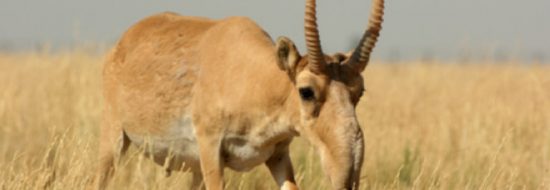
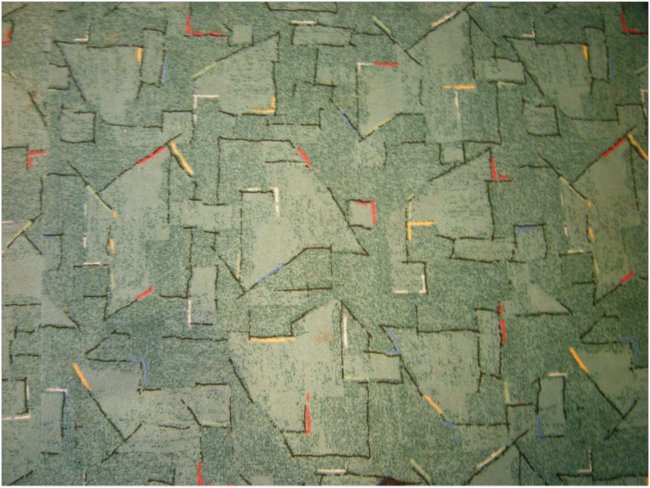
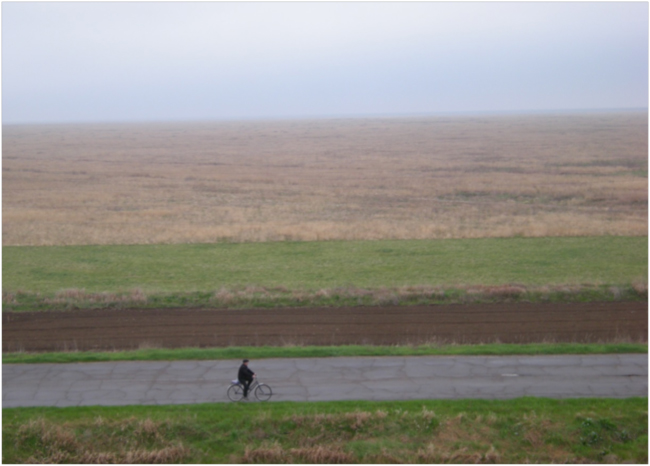
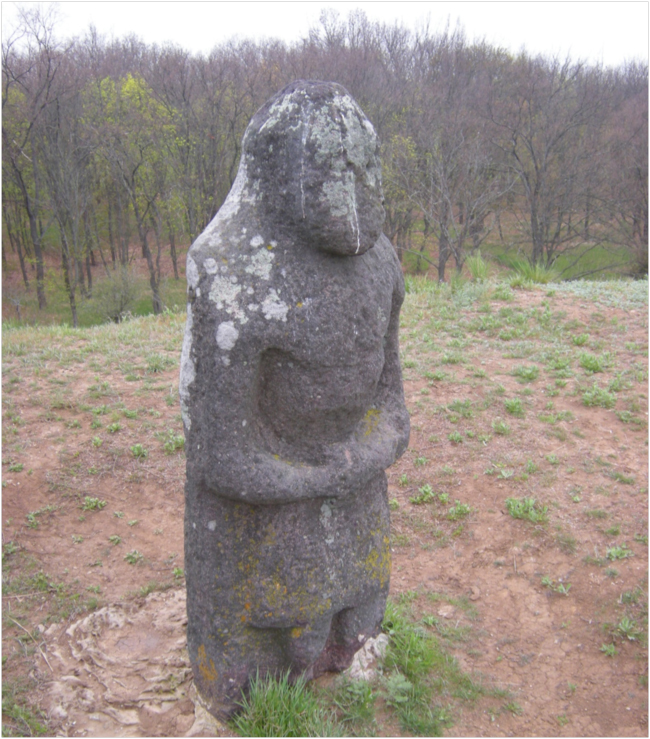
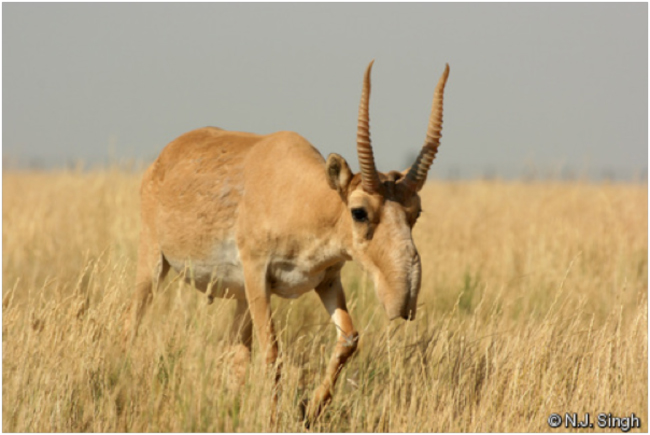
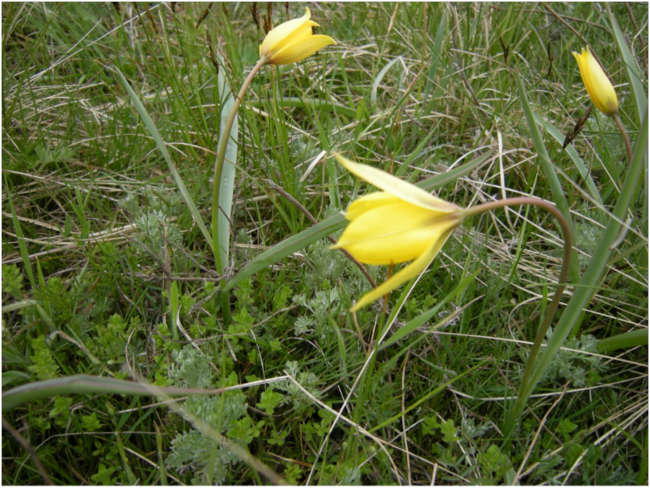
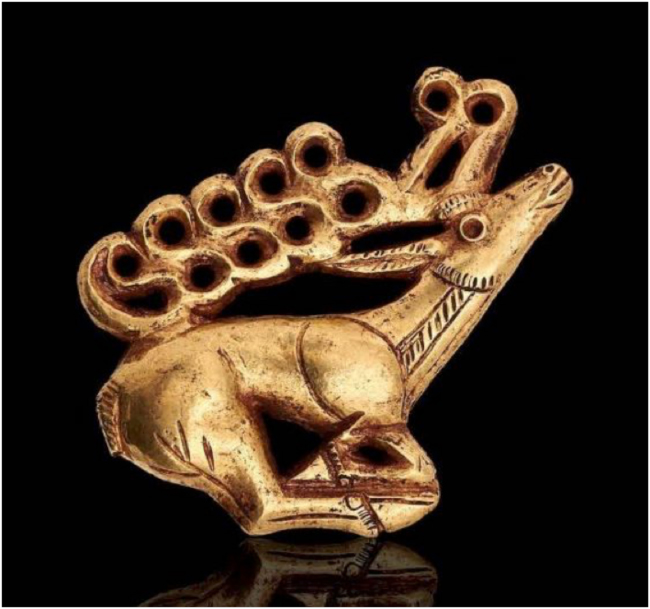



December 30, 2020 4:14 pm
Good morning,
First of all what I would like to say is that this is the most delightful nature reserve ever seen in the world. It consists of a lot of gorgeous animals such as saiga antelope, Przewalski’s horse, buffalo and many more. I wish I visited this place one day because I find it wonderful and irreplaceable.